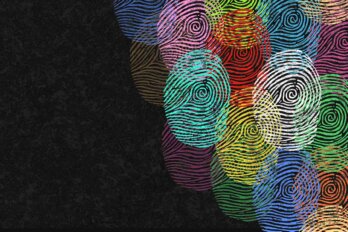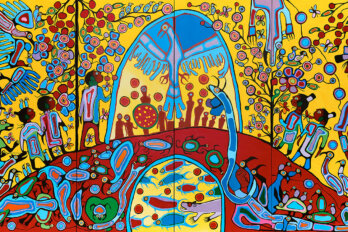One of comedian George Carlin’s seminal monologues was his 1986 riff on stuff. “Have you noticed that their stuff is shit and your shit is stuff?” I’m made aware of this every time family members visit my house and see the art I collect. I can imagine the conversations they have when driving away: “Do you think maybe all that art stuff he collects is a cry for help?”
I’ve written before about links between collecting and hoarding—recoding art-collecting and art-fair behaviour as subdued forms of hoarding. Basically: Where does collecting end and hoarding begin? One thing psychologists seem to agree on is that hoarding is grounded in deep loss. First, there needs to be a pre-existing hoarding proclivity (not uncommon, with our hunter-gatherer heritage). If someone with such a proclivity experiences a quick and catastrophic loss—often the death of a close relative, frequently in a car accident—hoarding generally kicks in within approximately eighteen to twenty-four months. TV reality shows on hoarding (A&E’s Hoarders; TLC’s Hoarding: Buried Alive) would have us believe that if hoarders are given dozens of helpers and a trained therapist, they can be cured by the end of an episode. The truth, though, is that there’s really no cure for hoarding. Once it’s there, it’s pretty much there to stay.
On these same TV shows, a voice-over regularly tells us that hoarding behaviour is unsanitary and unsafe, and both are correct. A few years back, a family friend—a big-game taxidermist who ended up making more money renting out mounted animals to TV and film shoots than he did with his trade—was killed in an electrical fire that began in his basement. He ran into his basement to try to put it out, got trapped, and quickly died of smoke inhalation. His retail storefront had always been immensely dense with hides and heads and antlers. Nobody was surprised to learn that his house had been just as crowded, but it was odd to think that his pack ratting might have been the result of a medical condition.
One of the borderline-ghoulish best parts of watching TV hoarding shows is seeing the expressions on the faces of hoarders once they realize that the intervention is for real. Their relatives are everywhere, poking out from behind mounds of pizza boxes and mildewed, second-hand Raggedy Ann dolls. There’s a huge empty blue skiff in the driveway, waiting to feast on all of their stuff, and it’s surrounded by a dozen gym-toned refuse movers. There’s a blond woman who looks like J. K. Rowling asking them how they feel about an oil-stained Velveeta box whose contents they ate on the morning the Challenger exploded.
Until then, it’s usually quite friendly, and in some cases hours can pass, and some deaccessioning progress is made, but then comes something—usually something utterly useless (a Jif peanut-butter jar, circa 1988, empty but not cleaned or rinsed)—and the hoarder chokes. From there, it’s only a matter of how much of a meltdown it’s going to be, and how ornery the hoarder needs to get before ejecting everyone from their house.
Needless to say, one feels a tingle of superiority knowing that one would never ever have one’s inner life come to a grinding halt over throwing out a twenty-eight-year-old unrinsed jar of peanut butter. But if not the Jif jar, what would it take to make you choke? Losing the nineteenth-century rocking chair? That small David Salle canvas? And wait—how did a Jif jar ever become shorthand for life and its losses? Is that what Andy Warhol’s Brillo boxes were all about? How does a postwar and contemporary art sale at Christie’s become a magic-wanding spectacle where, instead of peanut-butter jars, bits of wood and paint are converted from shit into stuff? How do objects triumph and become surrogates for life?
I think it was Bruno Bischofberger who said that the problem with the way Andy Warhol collected art was that he always went for lots of medium-good stuff instead of getting one or two truly good works. Warhol (the hoarder’s hoarder) would probably have agreed, but I doubt this insight would have affected his accumulating strategies.
A publisher I worked with in the 1990s had a living-room wall twelve-deep with Gerhard Richter canvases. God knows how many he has now, but however many it is, it will never be enough.
A few years back, I visited a friend of a friend in Portland who had a pretty amazing collection of post-1960 American work. He went to the kitchen, and when he came back he saw me staring into the centre of a really good crushed John Chamberlain.
“What are you staring at?”
“The dust.”
“What do you mean?”
“Inside this piece. There’s no dust on the outside bits, but it’s really thick in the middle.”
He looked. “I think that’s as far in as the housekeeper’s arms can reach.”
“Your housekeeper Windexes your art?”
I saw his face collapse. Later I believe the piece was professionally cleaned with carbon tetrachloride dry-cleaning solution at immense cost. It reminded me of reading about Leo Castelli, who wasn’t allowed to have regular housekeeping staff in his apartment. In order to keep his insurance, he had to have MFA students work as his housekeepers. I wonder if they’re now making MFA Roombas.
I think it’s perhaps also important to note that most curators almost never collect anything, and if you ever ask a minimalist curator what they collect, they often make that pained face that is actually quite similar to the Jif jar lover’s at the moment of possible surrender. “But you don’t understand; I have no choice in this matter. You merely see an empty apartment, but for me this apartment is full of nothingness. That’s correct: I hoard space.” A friend of mine is a manufacturer and seller of modernist furniture. Five years ago, he built a new showroom, and he was so in love with how empty it was, he kept it unused for a year as a private meditation space.
Most writers I’ve met, when they’re in the first half of their novel, stop reading other writers’ books because it’s so easy for someone else’s style to osmotically leak into your own, especially during a novel’s embryonic phase. I wonder if that’s why curators are generally minimalists—there’s nothing to leak into their brains and sway their point of view, which is perhaps how they maintain a supernatural power to be part of the process that turns air into millions of dollars.
On the other hand, most art dealers are deeply into all forms of collecting, as if our world is just a perpetual Wild West of shopping. I once visited a collector specializing in nineteenth-century works from the west coast of North America who had an almost parodically dull house at what he called “street level” in a suburb. But beneath his boring tract home were, at the very least, thousands of works arranged as though in a natural history museum.
Designer Jonathan Adler says your house should be an antidepressant. I agree. And so does the art world. When curators come home and find nothingness, they get a minimalist high. When dealers come home and find five Ellsworth Kellys leaning against a wall, they’re also high in much the same way. Wikipedia tells us, “Hoarding behaviour is often severe because hoarders do not recognize it as a problem. It is much harder for behavioral therapy to successfully treat compulsive hoarders with poor insight about the disorder.” Art collectors, on the other hand, are seen as admirable and sexy. Little chance they’re going to see themselves as being in need of an intervention. Perhaps the art-collecting equivalent of voluntarily getting rid of the Jif jar is flipping a few works.
Some people collect art that’s purely political, or purely conflict-based, or highly pedigreed by theory, but I wonder if they’re just trying to sidestep out of the spotlight of the art economy’s vulgarity. But wait—did they magically win their collection in a card game? Did their collection arrive at their doorstep, a gift from Santa Claus? No, it had to be purchased with money, and it’s at this level that the dance between academia, museums, and collectors turns into a beyond-awkward junior high school prom. I tried explaining a Tom Friedman work to my brother. Its title is A Curse, and the work consists of a plinth over which a witch has placed a curse. I told my brother it might easily be worth a million dollars, whereupon his eyes became the collective eyes of the Paris Commune, aching to sharpen the guillotine’s blades and then invade, conquer, and slay the London art fair Frieze.
The collecting of stuff—slightly out-of-the-ordinary stuff—is different now than it was in the twentieth century. Craigslist, eBay, and Etsy have gutted thrift and antique stores across North America of all their good stuff, and in Paris, the Marché aux Puces de Saint-Ouen is but a shadow of its former self. Once groaning with low-hanging fruit being sold by the clueless, eBay is now a suburban shopping centre with the occasional semi-okay vintage thingy still floating around.
This same sense of sparseness is felt in the museum world, where budget slashing remains the norm. As well, the fact of too much globalized money and not enough places to stash it has made pretty much anything genuinely good far too pricey for the 99 percent. The good stuff is always gone, and all the stuff that’s left is shit. You don’t stand a chance against moneyed, technologically advanced collectors who have some magic software that allows them to buy that Jean Prouvé stool three-millionths of a second ahead of you. Thank you, Internet.
I sometimes wonder if there’s a way to collect stuff without tapping into collecting’s dark, hoardy side. I got to thinking that if visual art is largely about space, then writing is largely about time—so then maybe people collect books differently than they do art.
Do they?
No, they don’t. Book hoarding tends to be just as intense as art hoarding, if not more. It’s called bibliomania and, like generic hoarding, is also a recognized psychological issue. Enter Wikipedia once again (and thank you, Jimmy Wales): “Bibliomania can be a symptom of obsessive-compulsive disorder which involves the collecting or even hoarding of books to the point where social relations or health are damaged . . . Other abnormal behaviours involving books include book-eating (bibliophagy) [and] compulsive book-stealing (bibliokleptomania).”
Bibliomania, though, is almost universally viewed as quirky and cute, the way kunstmania (my coinage) is seen as glamorous and cool in a Bond-villain kind of way. Oh, those booksellers sure are nutty! And they are nutty—pretty much all bookstore owners recognize that the profession brings with it a unique form of squirrelliness. The best booksellers, the antiquarian sellers especially, are those who genuinely don’t actually want to sell you the book. You have to audition for its ownership, and should they sell it to you, you can see the pain on their face as the cash machine bleeps. I once worked weekends in a bookstore. There was this guy who’d been coming in for years, and all the other sellers made cooing noises whenever he showed up for three hours every Sunday for some passionate browsing. “Now there’s someone who really loves books—a real book lover.” And then one Sunday afternoon, a New York Times atlas fell out of his raincoat as he was exiting the store. Police later found thousands of stolen books in the bibliokleptomaniac’s apartment.
As for bibliophagy, I chuckled when I learned of the term while writing this and then was chilled when I realized I’m a bibliophagist myself.
There is one thing that stops hoarding other than death—and that’s the actual approach of one’s own death and the thanatophobia that often accompanies it. One is forced to contemplate what will be written on one’s gravestone.
born
accumulated a bunch of cool stuff
died
The above epitaph isn’t creepy—it’s just boring. So how, then, do you manipulate your loot meaningfully while the clock ticks and ticks and ticks? For artists, dealing with stuff at the end of life becomes complicated. I find it interesting that, say, Constantin Brâncuși didn’t want to sell his work in his final years. He could afford not to, and he wanted to be surrounded by his own stuff. He wanted to live inside it. It’s no coincidence that when he died in 1957, he wanted his studio to be frozen in time at that moment. With its hundreds of paint tubes, Reece Mews, the studio of Francis Bacon, was one of the world’s most glamorous heavy-metals waste dumps. And one can’t help but always wonder about Andy Warhol, whose townhouse was stuffed with unopened bags of candy, cookie jars, jewels, and Duane Reade concealer. Did he ever open the doors of his rooms once they were full? Did he stop and stare at the doors, shiver, and then walk away?
In December of 2011, I saw a magnificent show at Stockholm’s Moderna Museet—Turner, Monet, Twombly: Later Paintings. It featured works by J. M. W. Turner, Claude Monet, and Cy Twombly. As the museum’s website explains, the show focused on their later work, “examining not only the art historical links and affinities between them, but also the common characteristics of and motivations underlying their late style.”
The paintings in the show were remarkable in and of themselves, yet what they collectively foregrounded was a sense of whiteness, a sense of glowing—an undeniable sense of the light that comes at the end of the tunnel. Overt content became less important, and the act of cognitive disassociation from the everyday world was palpable.
The works depicted, in their way, anti-hoarding—a surrendering of life’s material trappings. It was a liberating show that gave viewers peace. It let you know that maybe you should let go of many things in your life before that life is nearly over, that maybe your stuff isn’t as all-important as it was cracked up to be. (Guaranteed, if you ask anyone over fifty which would they rather have, more time or more money, they’ll almost always say more time.)
An obvious question here at the end is, wait—have art super-collectors, as well as bibliomaniacs, also experienced losses of a scope so great that they defy processing? Are these collectors merely sublimating grief via over-collecting? Reasonable enough, but why just limit it to collecting art or books? People collect anything and everything.
Back in our cave-dwelling days, if someone close to you died or got killed, chances are your life was going to be much more difficult for the foreseeable future, so you’d better start gathering as many roots and berries as you could. Collecting as a response to sudden loss makes total sense. But also back then, if you lived to thirty-five, you were the grand old man or dame of the cave, with very little time left on the clock. Divvying up your arrowheads and pelts made a lot of sense—best do it before your cave-mate descendants abandoned you on an ice floe.
Collecting and hoarding appear to be about the loss of others, while philanthropy and deaccessioning are more about the impending loss of self. (Whoever dies with the most toys actually loses.)
Maybe collecting isn’t a sickness, and maybe hoarding is actually a valid impulse that, if viewed differently, might be fixable through redirection tactics. Humanity must be doing something right, because we’re still here—which means there’s obviously a sensible way to collect berries and roots. There’s probably also a sensible way to collect art and books (and owl figurines and unicycles and dildos and Beanie Babies and . . .). The people who freak me out the most are the people who don’t collect anything at all. Huh? I don’t mean minimalists. I mean people who simply don’t collect anything. You go to their houses or apartments, and they have furniture and so forth, but there’s nothing visible in aggregate: no bookshelves, no wall of framed family photos—there’s just one of everything. It’s shocking.
“You mean you don’t collect anything?”
“No.”
“There must be something. Sugar packets? Hotel soaps? Fridge magnets? Pipe cleaners?”
“No.”
“Internet porn? Kitten videos?”
“No.”
“What the hell is wrong with you!”
“What do you mean?”
“If this was twenty thousand years ago and we all lived in a cave, you’d be an absolutely terrible cave mate. You’d be useless at foraging for roots and berries, and if you went hunting, you’d only have one arrowhead, so if you lost it,
you’d starve.”
“Where is this coming from, Doug?”
“Forget it. Let’s go gallery hopping right now.”
This appeared in the September 2016 issue.
Excerpted from Bit Rot. Copyright © 2016 Douglas Coupland. Published by Random House Canada, a division of Random House of Canada Limited, a Penguin Random House Company. Reproduced by arrangement with the Publisher. All rights reserved.






